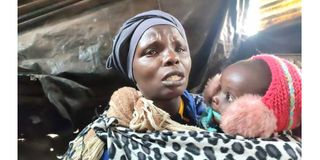A day in the life of a street mum

Mary Wambui, a woman who lives on the streets of Nairobi, breaks down during the interview from a shanty along the foul-smelling Nairobi River in the Grogan area on July 15, 2022.
What you need to know:
- They have nowhere to call home and have to beg from passersby and shoppers to be able to eat.
- They struggle to get out the streets but cannot for lack of a sustainable source of income.
I meet Mary Wambui turning clothes on a clothesline along the foul-smelling Nairobi River in the Grogan area of Nairobi City. It is a sunny Friday in mid-July, last year.
It is a few minutes past 10am. I am lucky to find her. Had I come five minutes later, she would be gone. Gone to where there was hope and life; at least for that day.
Well, she gave me hope too. Before my encounter with her, I had a very disappointing early morning. The news sources-women who live on the streets of Nairobi city - who had made me wake up at 4am had literally broken my heart into tiny little pieces.
The day before, they had agreed to the interview. And we set the interview for 6am. They had requested I carry along some foodstuffs for them.
But when I arrived at Jeevanjee Gardens encapsulated by Moi Avenue, Monrovia Street, Muindi Mbingu Street and Moktar Daddah street, they chased me away like a rained-on dog.
My head swung. I felt like I had been carried by a whirlwind.
Determined not to let my day go to waste, I reached out to an organisation that rescues and rehabilitates street children for help-Action for Children in Conflict.
Possible danger
Thankfully, they agreed to assist me, but warned that street persons can be dangerous owing to their substance addiction, especially glue. It was, therefore, unsafe for me to interview them by myself.
Two of their staff offered to accompany me. Our search for women to interview got me here. An area intoxicated with human urine and faeces.
The water at Nairobi River, which separates the garages on the right side from the shacks on the opposite side looks like tar. It is heavily polluted with all manner of waste.
Ms Wambui’s willingness to be interviewed was a sigh of relief considering that more than 10 women had already turned down our requests for an interview.
They were afraid. They thought we were plain-clothes “kanjo,” who wanted to arrest them. In the defunct City Council administration, enforcement officers were branded by Nairobi residents ‘kanjo’, a tag they have carried forward to the new leadership structure-Nairobi County government.
Tied to her back is her one-year and five-month-old son. He is the last born of her four children.
She was headed for Kariokor, north-east of the city centre.
“There is a Chinese investor in Kariokor who usually gives us pampers every Friday. He also gives us food alongside men and boys who live on the streets,” she says.
The previous day, she had washed her clothes, those of her child and her husband in a hospital in Ngara, which she says allows street persons to do their laundry and clean themselves, free of charge.
Ms Wambui has been on the streets since she was aged five. She was born in Mathare and when her mother died, she had no one to look after her.
Forage for food in waste bins
Her initial home was behind garbage bins in Eastleigh. She scavenged for food from these bins. Many times she would vomit and have a running stomach but the hunger was too much to bear. So, she ate until her stomach got used to the food. The vomiting and diarrhoea stopped.
She breaks down in her recollection of these distasteful events in her childhood.
Then one night, the police swooped on the area and she got arrested and taken to Muthaiga Police Station and thereafter to a children’s home in Kiambu.
“But I wouldn’t stand staying there. I was already used to life on the streets, so I ran away,” she says.
She has survived by begging from passersby and shoppers. But she says every street has its own kings and queens.
“Every street is someone’s territory. You have to find your own spot. Otherwise, you will be beaten up and for young girls, the boys will molest you,” she says.
She explains that when she came to the city centre, she started from the inner city but found it unsafe. The men and older boys were a threat to her. She moved to Biashara Street but came face to face with an established gang of street boys. She flew.
She positioned herself outside the now-closed Tuskys Supermarket along Moi Avenue. Sometimes, the big boys stole her money and took away the food given to her.
As she grew older, she learnt how to be part of the gang. This, she says, was the best strategy to survive on the streets.
But at some point, she got tired with life on the streets.
“There is no life on the streets. You eat anything. When it rains, you sleep in drenched clothes on cold or flooded pavements,” she says.
“You don’t even sleep in peace because you’re either worried about the ‘kanjo’ beating you up before they arrest you, or someone coming to rape you. What kind of life is that?”
She says, some of her friends were raped and last year, an adolescent girl who was new on the streets was defiled at Grogan area at night by the street boys.
She remembers her friend who was hit by a speeding car on the streets in 1997, and died. Countless times she has been arrested and later released, she says.
Determined to exit the streets, she invested the money she had received from begging in a second-hand clothing business.
She rented a room at Huruma slums for Sh1,500 and opened her business. Less than four months later, she was back on the streets.
“The business failed. I spent all the return on food and rent,” she laughs off her failure.
During the same period, she got married to a fellow street man.
Separation
Months later, they separated after having a son together. He took away the son.
She got into her second marriage while on the streets and gave birth to two daughters. Unfortunately, the marriage failed. She says her daughters were rescued by some non-governmental organisation, which enrolled her second-born in a school in Kiambu and put her third-born in a children’s home.
She is now in her third marriage and blessed with a son. Together with her husband who also lives on the streets, they have tried to escape from the torments of the Nairobi streets.
But life is seemingly unfair to them, she feels.
In 2019, they rented a room in a remote area in Limuru, Kiambu County. They pay a rent of Sh2,000.
Covering that cost has, however, been an uphill task forcing them to spend most of their time on the streets rather than in the house.
They wanted to start a decent life, she says. Their plan was to start selling shoes and lesos-woven wraps.
“There isn’t enough money for us to save. Whatever we get goes into rent and food,” she says.
And since they have to make money, they have to get out of the house.
Her husband collects waste food and sells it as food for the pigs. While she begs from Monrovia Street. She targets shoppers heading or coming out of Naivas Supermarket.
“If a shopper is unwilling to give me money, I request them to buy me food and diapers that can last me a week. I prefer maize flour over a packet of milk or bread,” she says.
Once they have collected enough to cover the rent and at least two weeks of stay in their Limuru house, they retract to their abode.
“It is comfortable sleeping in the house. You sleep soundly and rest well. You also eat good food,” she says.
Sadly, the good life is short-lived - they return to the streets once they run out of food and money. Well, at the end of the interview, she tells me I have to shop for her necessities to last her all week since I disrupted her day and made her miss the goodies she was to receive at Kariokor. I oblige and do so at the Naivas Supermarket on Monrovia Street.
Ms Wambui is a unique case of a street woman struggling to get out of the streets but is unable to due to an unsustainable source of income.
A 2018 National Census of Street Families Report by the Ministry of Labour And Social Protection found that 46,639 persons live on the streets across Kenya. Of these, 72.4 per cent were men and 27.6 per cent women.
But only 7,206 had been rehabilitated. Of these, 16 per cent were men and eight per cent were women. The report further shows that the 64 per cent of street persons who had been rehabilitated or reintegrated into society were aged between 15 to 30 years.
Considering that Ms Wambui says she became a street person in 1995 when she was five years, means presently she is 32. By 2018 when the study was done, she was 28; which shows that there are many in her age group who never got to be rehabilitated or reintegrated into society.
Women who live on the streets have much more to endure than homeless men do.
Mary Wambui chairs the Street Families Rehabilitation Trust Fund, charged with coordinating rehabilitation activities for street families. She says taking individuals out of the streets is a complicated task.
“The biggest challenge is that most of them don't want to go back home. They want to remain in the city centre and as social workers, we can’t force them if they don’t want to,” she says. “That’s why even if they are reintegrated they return to the streets.”
She says the agency mainly targets children. For adults, it reaches them with information on where they can access support, especially on starting businesses.
She, however, notes that limited resources have constrained their outreach programmes. She says they have partnered with various organisations where street women are equipped with skills in baking and catering.
Perhaps, for now, all Ms Wambui is looking forward to is an outreach activity where she will be informed of where she can access capital to start her dream business-selling shoes and woven wraps.
“I don’t want to live on the streets forever,” she says.





